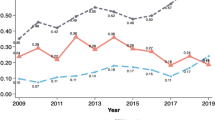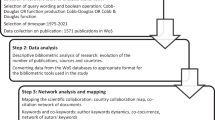Abstract
Previous studies suggest a preference for emissions taxes over (non-auctioned) emissions permits and performance standards based on their potential for promoting technological innovation. We present simulation results that cast some doubt on the empirical importance of this assertion: the welfare gain induced by an emissions tax is significantly larger than that induced by other policies only in the case of very major innovations. We also find that the presence of technology spillovers per se does not necessarily imply large inefficiencies. Thus, despite spillovers, the welfare gain from additional policies to promote innovation (such as R&D subsidies) may be limited.
Similar content being viewed by others
References
Biglaiser, Gary, and John K. Horowitz. 1995. “Pollution Regulation and Incentives for Pollution Control Research.” Journal of Economics and Management Strategy 3 (no. 4, Winter): 663–684.
Carlton, Dennis W., and Jeffrey M. Perloff. 1990. Modern Industrial Organization. Glenview, II: Scott-Foresman.
Cropper, Maureen L., and Wallace E. Oates. 1992. “Environmental Economics: A Survey.” Journal of Economic Literature 30 (no. 2, June): 675–740.
Dasgupta, Partha and Joseph E. Stiglitz. 1980. “Uncertainty, Industrial Structure and the Speed of R&D.” The Bell Journal of Economics 11 (no. 1, Spring): 1–28.
Downing, Paul G. and Lawrence J. White. 1986. “Innovation in Pollution Control.” Journal of Environmental Economics and Management 13 (no. 1, March): 18–29.
Goulder, Lawrence H., Ian W.H. Parry, Roberton C. Williams, and Dallas Burtraw. 1998. “The Cost-Effectiveness of Alternative Instruments for Environmental Protection in a Second-Best Setting.” Discussion paper no. 98–22. Washington, DC: Resources for the Future.
Goulder, Lawrence H. and Koshy Mathai. 1997. “Optimal CO2 Abatement in the Presence of Induced Technological Change.” Unpublished manuscript, Stanford University, CA.
Jaffe, Adam B. and Robert N. Stavins. 1995. “Dynamic Incentives of Environmental Regulation: The Effects of Alternative Policy Instruments on Technology Diffusion.” Journal of Environmental Economics and Management 29, part 2 (no. 3, November): S43-S63.
Jung, Chulho, Kerry Krutilla, and Roy Boyd. 1996. “Incentives for Advanced Pollution Abatement Technology at the Industry Level: An Evaluation of Policy Alternatives.” Journal of Environmental Economics and Management 30 (no. 1, January): 95–111.
Lee, Tom and Louis Wilde. 1980. “Market Structure and Innovation: A Reformulation.” Quarterly Journal of Economics 94 (no. 2, March): 429–436.
Levin, Richard C., Alvin K. Klevorick, Richard R. Nelson, Sidney G. Winter. 1987. “Appropriating the Returns from Industrial Research and Development.” Brookings Papers on Economic Activity 3 (Special Issue on Microeconomics): 783–820.
Loury, Glenn C. 1979. “Market Structure and Innovation.” Quarterly Journal of Economics 93 (no. 3, August): 395–410.
Mansfield, Edwin. 1985. “How Rapidly does new Industrial Technology Leak Out?” Journal of Industrial Economics 34 (no. 2, December): 217–23.
Mansfield, Edwin, John Rapoport, Anthony Romeo, Samuel Wagner, and George Beardsley 1977. “Social and Private Rates of Return from Industrial Innovations.” Quarterly Journal of Economics 91 (no. 2, May): 221–240.
Mansfield, Edwin, Mark Schwartz and Samuel Wagner. 1981. “Imitation Costs and Patents: An Empirical Study” Economic Journal 91 (December): 907–918.
Milliman, Scott R. and Raymond Prince. 1989. “Firm Incentives to promote Technological Change in Pollution Control.” Journal of Environmental Economics and Management 17 (no. 3, November): 247–265.
Newell, Richard G., Adam B. Jaffe, and Robert N. Stavins. 1998. “Energy-Saving Technology Innovation: The Effects of Economic Incentives and Direct Regulation.” Discussion paper no. 98–12. Washington, DC: Resources for the Future.
Oates, Wallace E. and Diana L. Strassmann. 1984. “Effluent Fees and Market Structure.” Journal of Public Economics 24 (no. 1, June): 29–46
Parry, Ian W.H. 1995. “Optimal Pollution Taxes and Endogenous Technological Progress.” Resource and Energy Economics 17 (no. 1, May): 69–85.
Robison, H. D. 1985. “Who Pays for Industrial Pollution Abatement?” Review of Economics and Statistics 67 (no. 4, November): 702–706.
Spulber, Daniel F. 1985. “Effluent Regulation and Long-Run Optimality.” Journal of Environmental Economics and Management 12 (no. 2, June): 103–116.
Tirole, Jean. 1988. The Theory of Industrial Organization. Cambridge, MA: MIT Press.
Wright, Brian D. 1983. “The Economics of Invention Incentives: Patents, Prizes and Research Contracts.” American Economic Review 73 (no. 4, September): 691–707.
Author information
Authors and Affiliations
Rights and permissions
About this article
Cite this article
Parry, I.W. Pollution Regulation and the Efficiency Gains from Technological Innovation. Journal of Regulatory Economics 14, 229–254 (1998). https://doi.org/10.1023/A:1008079223033
Issue Date:
DOI: https://doi.org/10.1023/A:1008079223033




